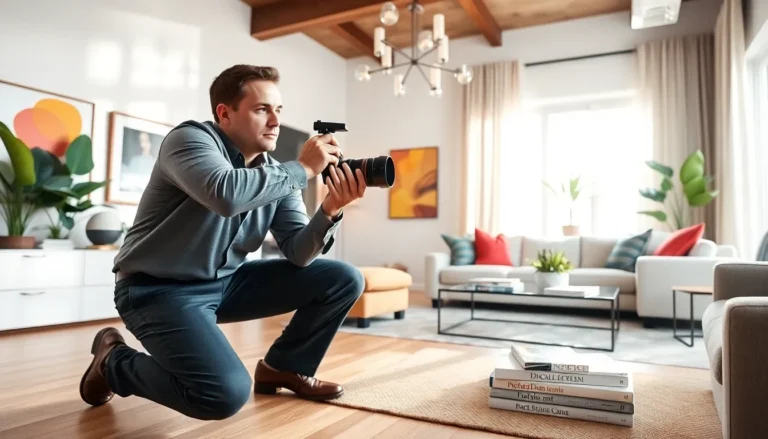When it comes to creating beautiful spaces, many people think it involves a secret language only designers understand. Spoiler alert: it doesn’t. Design and decor can be mastered by anyone who’s willing to learn. Whether she’s trying to turn a drab living room into a cozy retreat or he’s eager to make his office feel more inspiring, there’s a world of principles, trends, and personal touches just waiting to be explored. Let’s jump into the essentials of design and decor, and who knows, you might just uncover your inner decorator.
Table of Contents
ToggleUnderstanding Design Principles

Design is more than just making things look pretty: it’s about creating spaces that function well and resonate personally.
Elements of Design
Every masterpiece begins with its elements. Think of them as the building blocks of any good design. These include:
- Color: The mood-setter, color can make any space feel warm, cool, vibrant, or subdued. Choosing the right palette can dramatically alter how a space feels.
- Line: The unseen thread that guides the eye. Straight, curved, and diagonal lines can create different visual effects, from energy to calm.
- Shape: Whether geometric or organic, shapes compose the structure of any design.
- Texture: This often-overlooked element adds depth. Mixing various textures creates dimension and intrigue.
- Space: Understanding how to use space effectively allows for better flow and accessibility. It’s about finding balance between what’s filled and what’s left open.
Principles of Design
Equally important are the principles that guide these elements. They include:
- Balance: Achieving equilibrium in a room, whether symmetrical or asymmetrical, is key to a pleasing aesthetic.
- Contrast: This principle is all about opposites. Mixing light and dark colors or different materials can create a striking visual impact.
- Emphasis: What’s the focal point of your space? Every room should have a visual anchor, whether it’s a stunning piece of art or a unique light fixture.
- Unity: Everything needs to feel cohesive. If the colors, textures, and lines in a design don’t work together, the space can feel disjointed.
Trends in Home Decor
Staying updated with trends can breathe new life into any space. But what are the hot topics right now?
Color Psychology in Design
Color isn’t just decoration: it’s a tool for influencing emotions. For instance, soft blues can invoke tranquility, while yellows can foster creativity. Designers are increasingly using color psychology to craft environments that truly resonate with the intended vibe of each room.
Sustainable and Eco-Friendly Decor
More homeowners than ever are prioritizing sustainability. This trend includes everything from using reclaimed materials to supporting local artisans. It’s not just stylish: it’s an ethical choice that contributes to a healthier planet. Choosing eco-friendly options can also add unique character to spaces.
Tailoring Designs to Space and Functionality
Understanding the purpose and size of a space is crucial for effective design.
Small Spaces: Maximizing Functionality
In smaller homes, every square inch counts. Clever storage solutions, multi-functional furniture, and strategic layouts can help make even the tiniest rooms feel spacious. Think about items that can serve more than one purpose, like a storage ottoman or a couch bed.
Open Concept Living: Design Approaches
Open concepts are all about flow, but it can be a challenge to define different areas without walls. Using rugs, furniture placement, and subtle color changes can help delineate spaces while maintaining an airy feel.
Creating a Cohesive Look
Bringing it all together often means marrying different styles while keeping harmony.
Mixing Styles: Modern and Traditional
Combining traditional and modern elements can produce stunning results. It’s like choosing the best of both worlds. Pairing sleek modern furniture with vintage decor can create a unique and inviting atmosphere. The key is moderation, too much contrast can feel chaotic.
Layering Textures for Visual Interest
Textures can transform the feel of a room, providing depth and warmth. Consider mixing materials like wood, metal, and fabric to create a tactile experience. Layering throws on a couch or combining different area rugs can make a space visually captivating.
The Importance of Personal Touches
Even the most professionally designed spaces need a dash of personality.
Incorporating Personal Mementos
Incorporating family photos, travel souvenirs, or meaningful artworks can make a space truly feel like home. Those little things, as seemingly simple as a unique vase or an heirloom piece, tell your story and add warmth.
Finding Balance Between Aesthetic and Comfort
While style is vital, comfort can’t be overlooked. Furniture should not just look good: it must invite people to sit and stay awhile. Striking the perfect balance ensures that spaces are both beautiful and livable.



